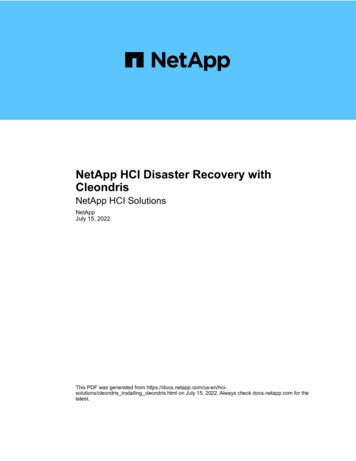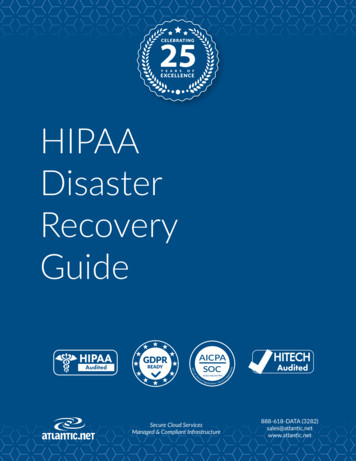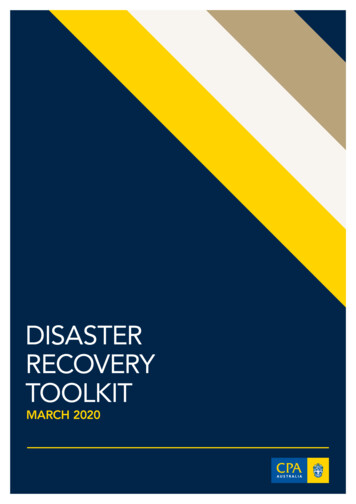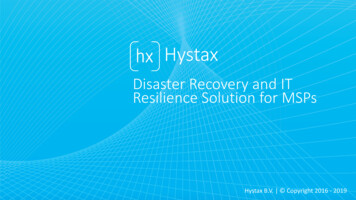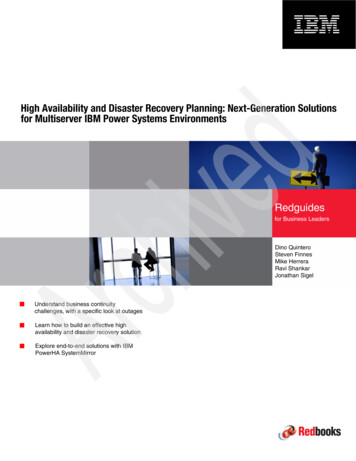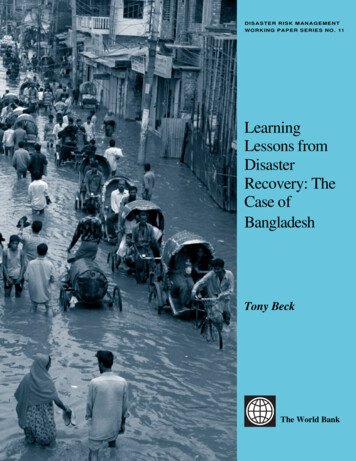
Transcription
DISASTER RISK MANAGEMENTW O R K I N G P A P E R S E R I E S N O . 11LearningLessons fromDisasterRecovery: TheCase ofBangladeshTony BeckThe World Bank
The Hazard Management Unit (HMU) of the World Bank provides proactive leadership in integratingdisaster prevention and mitigation measures into the range of development related activities and improvingemergency response.The HMU provides technical support to World Bank operations; direction on strategy and policydevelopment; the generation of knowledge through work with partners across Bank regions, networks, andoutside the Bank; and learning and training activities for Bank staff and clients. All HMU activities are aimedat promoting disaster risk management as an integral part of sustainable development.The Disaster Risk Management Working Paper Series presents current research, policies and tools underdevelopment by the Bank on disaster management issues and practices. These papers reflect work inprogress and some may appear in their final form at a later date as publications in the Bank’s officialDisaster Risk Management Series.Margaret ArnoldProgram ManagerHazard Management UnitThe World Bank1818 H Street, NWWashington, DC 20433Email: hazardmanagement@worldbank.orgWorld Wide Web: http://www.worldbank.org/hazardsCover Photo: Rafiqur Rahman/Reuters/Corbis
Hazard Management UnitWORKINGPAPERSERIESNO. 11Learning Lessons from DisasterRecovery: The Case of BangladeshTony BeckThe World BankWashington, D.C.April 2005
Abbreviations and USAIDUSDAVGDWFPWHOWRPOAction by Churches TogetherAssociation of Development Agencies in BangladeshAsian Development BankAnnual Development ProgrammeAsia Disaster Preparedness CenterAction Learning Network for Accountability and ParticipationAssociation of Non-Governmental Organizations of HondurasBangladesh Rural Advancement CommitteeBangladesh Water Development BoardCooperative for Assistance and Relief Everywhere, Inc.Canadian International Development AgencyDisaster Emergency CommitteeDepartment for International DevelopmentDisaster Management BureauDisaster Mitigation InstituteDirectorate of Relief and RehabilitationEuropean CommissionEuropean Commission for Humanitarian OrganizationFlood Action PlanFlood Forecasting and Warning CenterGross Domestic ProductGonoshasthya KendraGovernment of BangladeshHellen Keller InternationalInternational Development AgencyInternational Food Policy Research InstituteInternational Federation of Red Cross and Red Crescent SocietiesInternational Monetary FundInternational Strategy for Disaster ReductionJapan International Cooperation AgencyMinistry of Disaster Management and Relief (now MFDM)Ministry of Food and Disaster ManagementMicro-finance institutionMetric tonsNon-Governmental OrganizationOperations and MaintenancePrime Minister’s OfficeRural Maintenance ProgrammeUnited Nations Development ProgrammeUnited Nations Children FundUnited States Agency for International DevelopmentUnited States Development AgencyVulnerable Group DevelopmentWorld Food ProgrammeWorld Health OrganizationWater Resource Planning Organization
Table of ContentsPreface. iiiExecutive summary . iv1. Introduction and Background.11.1. The ProVention Consortium lesson learning review.11.2. Background to the Bangladesh case study.12. Background to Natural Disasters in the Country .32.1. The extent of natural disasters in Bangladesh.32.2. Recovery in the Bangladesh context.32.3. The 1998 floods - what they meant for the recovery program.42.4. The agricultural sector.52.5. The manufacturing sector.53. Policy .73.1. Conceptualizing floods in Bangladesh.73.2. The Flood Action Plan.83.3. Food security.94. Systems. 104.1. Government institutions dealing with recovery. 104.2. Preparedness and mitigation leading up to the 1998 floods. 104.3. Coordination . 115. Resources. 135.1. Overall allocations and disbursements. 135.2. Allocation by donors. 145.3. Expenditures by NGOs. 165.4. Sectoral allocations. 166. Livelihoods. 186.1. Vulnerability and livelihoods in the Bangladesh context. 186.2. Understanding of vulnerability and livelihoods in the recovery phase. 187. Impact. 227.1. Impact of infrastructure and food aid. 237.2. Government response. 247.3. NGO assessments. 257.4. Housing. 267.5. Cross-cutting themes. 278. Conclusions. 28
iiReferences. 30Boxes3.1. Good practice in food security during the recovery period after major floods in Bangladesh.96.1. Livelihoods and credit. 207.1. Learning from the 1988 to 1998 floods. 227.2. Good practice in recovery – the case of BRAC . 26Tables2.1. Vulnerability to natural disasters, 1970 - 1998.32.2. Flood effects, 1988 and 1998.55.1. Allocation by major donors for recovery. 155.2. Recovery funding by NGOs following the 1998 floods. 167.1. Imports under Emergency Flood Recovery Project. 23
iiiPrefaceThis report summarizes the findings of a country case study on Bangladesh, which is part of a ProVentionConsortium initiative aimed at learning lessons from recovery efforts following major natural disasters. TheProVention Consortium is an international network of public, private, non-governmental, and academicorganizations dedicated to reducing the impacts of disasters in developing countries. The activity wasmanaged by the World Bank, and benefited from the guidance and conceptual inputs of a number ofProVention partners.The study team for this initiative consisted of: Alcira Kreimer and Margaret Arnold, who served as co-taskteam leaders of the activity on behalf of the Hazard Management Unit (formerly the Disaster ManagementFacility); Tony Beck (lead consultant, India and Bangladesh desk reviews); John Telford (Honduras countrymission and dissemination report); Peter Wiles (Mozambique country mission and Turkey desk study); and,Jonathan Agwe, Umkulthum Himid, María Eugenia Quintero, and Zoe Trohanis (research, editing, andadministrative support). Margaret Arnold and Alberto Harth also participated in the Honduras countrymission. Kerry Selvester, Lourdes Fidalgo and Isabel Guzman of the Food Security and NutritionAssociation, Maputo, carried out the Mozambique community survey. The Disaster Mitigation Institute(DMI), Ahmedabad, carried out the India community survey under the direction of Mihir Bhatt. Alberto Harthsupervised the Honduras community survey, which was carried out by ASONOG, and in particular MaríaLópez. Professor Nurul Alam of the Department of Anthropology, Jahanirnagar University, Dhaka, wrote abackground paper for the Bangladesh desk review. Professor Polat Gulkan of the Disaster ManagementResearch and Implementation Center, Middle East Technic al University, wrote a background paper for theTurkey desk review.The guidance and support of the ad hoc committee that supervised the review is deeply appreciated:Margaret Arnold (World Bank), Yasemin Aysan (UNDP), Mihir Bhatt (DMI), John Borton (independentconsultant), Eva von Oelreich (IFRC), Fenella Frost (DFID), Alberto Harth (CIVITAS), Alcira Kreimer (chair,World Bank), Ronald Parker (World Bank), David Peppiatt (ProVention Consortium), Aloysius Rego (ADPC),Sálvano Briceño, and Helena Molin Valdés (ISDR).Thanks also go to a number of World Bank staff who supported this initiative and provided valuable inputs tothe Bangladesh country study: John Flora, James Fitz Ford, Sonia Hammam, Kapil Kapoor, EnriquePantoja, Maryvonne Plessis-Fraissard, Katherine Sierra, Nemat T. Shafik, Frederick Temple, and ChristineI. Wallich.Funding for the study was provided by the World Bank’s Hazard Management Unit, the UK’s Department forInternational Development, and the Norwegian Ministry of Foreign Affairs through the ProVentionConsortium. Their generous support is greatly appreciated.
ivExecutive summaryBackgroundThis study is part of a five-country review of lessons learned from recovery after major natural disasters. Theother four country studies – on Honduras, India, Mozambique and Turkey – have been completed, and aSynthesis Report will be issued that summarizes the findings of the review. The lesson learning review as awhole has analyzed the strengths and weaknesses of recovery assistance from governments, donors, andcivil society following major natural disasters, with a focus on identifying replicable good practice.Bangladesh was selected as a case study as it is representative of a predominantly agricultural developingcountry with high levels of rural poverty; in addition, it is extremely susceptible to natural hazards, especiallyfloods. A particular focus of this study has been on the recovery of poorer households, as these householdsare usually most in need of external support following major natural disasters.The 2004 floods and tsunami disasterThis report focuses on lessons from the recovery period following the 1998 floods. Bangladesh is a countrythat is highly vulnerable to a number of hazards including cyclones, droughts, flooding and earthquakes.During the 2004 monsoon season, Bangladesh experienced severe flooding across 33 districts that affectedapproximately 36 million people and killed nearly 800 people. Over 2 million acres of agricultural land wasdamaged, and approximately 4 million houses were either partially damaged or completely destroyed. Totaldamage caused by the floods was estimated at US 2.28 billion, with the most severe losses concentrated inthe housing, transport, and agricultural sectors. Additional flooding occurred again in September, paralyzingparts of Dhaka and inundating southwestern districts that were not affected by the first monsoonemergency. In addition the December 26, 2004 tsunami in the Indian Ocean also affected Bangladesh’scoastline, causing relatively minimal damage and several deaths. It is hoped that the findings of this studycan contribute to the recovery efforts of the most recent events, and help to inform efforts for more effectiverisk reduction in the country.As indicated in this study, the impacts of these events suggest that several factors continue to contribute tothe country’s vulnerability to disasters, including rapid urbanization, population growth, inadequatemaintenance of infrastructure systems, and poor environmental management.The 1998 floodsThe 1998 floods appeared to be qualitatively different from major floods in the previous 20 years, becauseof the length of the flood period, which was about 10 weeks. Whether the extended length of the flooding isa one-off phenomenon is impossible to predict. About 30 million people and 68 percent of the country wereaffected, as opposed to about 30 percent in a normal flood year. The floods affected different sectors indifferent ways. Although a large portion of the aman (winter) crop was destroyed, the agricultural sectorevidenced increased yields due to a good boro (spring) crop; and the construction industry grew by eightpercent in 1998/99. Manufacturing and private investment showed a significant downturn, including in thedominant garment industry, although it is difficult to disentangle the effects of the floods from more generalpatterns of disinvestment, partly caused by political uncertainty in Bangladesh.PolicyCurrent thinking on vulnerability, disasters and recovery is being integrated, at a slow pace, into nationaland donor planning documents. A significant shift is from a focus on flood control to flood proofing, that is, toa less interventionist stance that takes into account livelihood strategies of the affected population. Floodsare also being viewed as part of the development continuum, rather than as discrete geographical events.
vThe main reasons for this change are pressure from civil society in Bangladesh, and the shift in focus in thedisaster paradigm itself.The Government of Bangladesh’s policy after 1994 facilitating private sector food imports appears to havesignificantly improved the response to the 1998 floods. After the 1998 floods, the government promotedprivate sector imports through removal of the 2.5 percent development surcharge on rice imports, andinstructed customs officers to expedite clearance of rice imports. Between July 1998 and April 1999, privatesector imports equaled 2.42 million metric tons (MTs) and government imports equaled 399,000 MTs, whichmet a substantial percentage of the shortfall caused by the floods. This was probably one of the mainfactors in keeping the price of rice stable from September 1998 to mid-April 1999, a key issue for poorerhouseholds.SystemsBangladesh has over the last decade developed machinery for disaster response, including a DisasterManagement Act and a National Disaster Management Plan. However, limited evidence of governmentcoordination was found in the recovery phase, while NGO coordination was assessed as positive overall.Despite a lack of long-term forecasting capacity, almost all reports and studies note that Bangladesh wasbetter prepared in 1998 than in 1988, the last major flood.ResourcesAssessing levels of disbursement to recovery activities is complicated by the overlapping budget headingsfor relief, recovery, and development interventions of the main recovery actors, and reallocation of funds torecovery by these actors from ongoing projects. While significant resources were originally allocated bydonors, it appears that, overall, new disbursements were limited. This is in contrast to concurrent disasters(e.g. Hurricane Mitch in Honduras) where substantial amounts of new funds were disbursed. Sectorally, themajority of recovery funds were allocated to infrastructure projects and agricultural credit. The World Bankand Asian Development Bank (ADB) both combined aspects of a number of ongoing projects to create anew flood recovery project; while this may make sense from an administrative and policy perspective, it mayalso make evaluation of the recovery phase difficult. Despite the widespread loss of housing, major donorsdid not make housing reconstruction a priority, and it is not clear why this is the case.LivelihoodsUnderstanding of, and attempts to build on livelihoods after the floods, was patchy. There is almost nodiscussion of livelihoods in the major infrastructure projects, i.e., in the case of the majority of funds beingdisbursed. NGO and academic reports cover livelihoods in more detail. The following were the mainstrategies used by poorer households: Cutting back in non-food expenditure, which lasted for at least a year after the peak of the floods. Distress sales of assets, including small livestock. It was extremely difficult for poorer householdsto recover these assets. Borrowing to purchase food and to fund other expenses. This was of particular importance. Due toinsufficient availability of credit, poorer households were forced to take exploitive loans frommoneylenders or wealthier neighbors.ImpactThere is a general consensus that the response after the 1998 floods was more effective than in 1988.Attention paid to disaster preparedness in the decade prior to the 1998 floods relative to the 1988 floods.
viThe main reasons for this appear to be: the growth of civil society since 1991, and in particular the role ofNGOs as both service providers and advocates for a more democratic society; economic growth andreduction in poverty levels; changes in crop patterns resulting in an increase in the relative size of the boroharvest, which has largely reduced the seasonality of production and prices, and the susceptibility of totalproduction to adverse weather; and investment in preparedness, which produced tangible benefits inreduced loss of lives, livestock, and property.There is very limited discussion of any wider potential impacts of rehabilitation of infrastructure, for examplethe likely socio-economic, gender equality or environmental impacts. Clearly, greater attention is needed inthe planning of infrastructure in the recovery phase to ensure that communities are consulted and theirpriorities are being met.The focus of major donors on infrastructure may be one of the reasons why the understanding of, andattempts to build on, livelihoods after the floods was patchy. There is almost no discussion of livelihoods inthe major infrastructure projects, a situation which the GOB and donors need to address. While severallarge infrastructure and transfer of payment projects aimed at promoting economic growth, they still neededto establish how economic growth would support livelihoods for direct poverty reduction. The debates onstructural as opposed to non-structural interventions in the Flood Action Plan through the 1990s are alsorelevant to the introduction of infrastructure after major floods. In addition, corruption issues, which wereinsufficiently dealt with by reports, are systemic problem s in the country that have often surroundedinfrastructure projects in Bangladesh (DFID 2002).NGO assessments, including independent assessments, are generally positive about the impact of recoveryprograms. While NGO programs in Bangladesh are extensive, their post-disaster assistance wasconsiderably smaller than that provided by major donors. However, one of the least successful recoveryrelated interventions over the last decade after natural disasters in Bangladesh appears to be housing.Problems encountered include: poor targeting; lack of standards; limited community participation, andinappropriate design.Main lessons learned from this study are:1. Policy and planning Government policy that manages the food supply in a flexible manner, including allowing privatesector food imports, can help to stabilize the price of staple foods after major natural disasters.However, public intervention in food management and operation is essential. Households living in marginal environments worst impacted by floods are often permanently in therelief phase of development. Planning a relief to development continuum may need to be rethoughtfor interventions related to these households. A second needs assessment could be carried out at the start of the recovery phase, in order toprioritize communities and individuals in need. This could also be used to understand ways ofbuilding on existing livelihoods. There was insufficient credit available in the recovery period, even despite the very widespreadnetwork of Bangladeshi micro-finance institutions. In terms of supporting livelihoods, this should bethe first priority of external agents. NGOs with an ongoing development program are most likely to be effective in the recovery phaseat targeting poorer households and supporting their livelihoods.
vii2. Supporting livelihoodsBased on a review of post-1998 flood and other documents over the last 10 years, the areas that could becovered in future interventions to support livelihoods include: Access to reliable sources of credit at low interest rates; Provision of seeds, particularly vegetable seeds and tree seedlings which will be of use to landlesshouseholds able to grow vegetables on their homestead land; Replenishing the asset base of the poor, in particular provision of small livestock suc h as chickens,ducks and goats; Cash and food for work programs which involve rehabilitation of local infrastructure used by or ofuse to the poor; Reconstruction of education and health facilities with local materials and labor; Support in reconstructing housing that is adaptable to flooding, such as movable housing orhousing made from sturdier materials, using local materials and labor; and Provision of information as to recovery resources available from the GOB and NGOs.3. Understanding the impact of floods and recovery interventionsRecovery interventions are not coming under adequate external scrutiny, partly because they are stillconsidered to be taking place in a near-emergency situation. Greater attention needs to be paid to the effectof recovery efforts on different groups among the poor, including female-headed households. Some of theareas that need greater attention are: the effects of food imports and agricultural credit on agricultural laborwage rates; the impact of infrastructure interventions on livelihoods; and the impact on gender inequality.
viii
1Chapter 1.Introduction and Background1.1The ProVention Consortium lesson learning reviewThis report is part of a five-country review of lessons learned from recovery after major natural disasters. Theother four country studies – on Honduras, India, Mozambique and Turkey – have been completed, and aSynthesis Report summarizing the findings of the review that draws out similarities and differences betweenthe various experiences of recovery will be published.The lesson learning review has analyzed the strengths and weaknesses of recovery assistance fromgovernments, donors and civil society following major natural disasters. Lessons learned and good practiceidentified through this analysis will be of use to the donor community and governments in developing moreeffective policies and procedures, and in crafting future disaster assistance programs. For this reason onefocus of the exercise is on how replicable good practice is achieved, and how constraints to overcoming goodpractice are overcome. The review has been made up of: country visits (Honduras, India, and Mozambique);desk studies (Bangladesh and Turkey); and community surveys (Honduras, India, and Mozambique), with astrong focus on understanding recovery-related livelihoods of the affected population, and whether thesehave been supported by external interventions. Countries were selected so as to provide a representativepicture of recovery.The ProVention Consortium is a global coalition of governments, international organizations, academicinstitutions, the private sector, and civil society organizations aimed at reducing disaster impacts indeveloping countries. The Consortium functions as a network to share knowledge and to connect andleverage resources to reduce disaster risk. It focuses on synergy and coordination so that efforts, andbenefits, are shared. Further details on the ProVention Consortium and its work can be found at www.proventionconsortium.org .For the review as a whole Tierney’s (1993) definition of recovery has been used:Longer-term efforts to (1) reconstruct and restore the disaster-stricken area, e.g. throughrepairing or replacing homes, businesses, public works, and other structures; (2) deal withthe disruption that the disaster has caused in community life and meet the recoveryrelated needs of victims; and (3) mitigate future hazards.Further background details on the review can be found in ProVention Consortium (2002).1.2Background to the Bangladesh case studyBangladesh was selected as a case study as a predominantly agricultural developing country with high levelsof rural poverty, which is extremely susceptible to natural hazards, in particular floods. Bangladesh was alsoselected as there is much that is comparable between the major floods of 1988 and 1998, the two worstfloods of the century. One aim of this desk review was to assess what lessons had been learned between thetwo floods, and why. A particular focus of this study has been on the recovery of livelihoods of poorerhouseholds, as these households are usually most in need of external support after major natural disasters.The recovery phase is defined here as the period from approximately three months to 21 months after thepeak of the floods, that is from December 1998 to August 2000.
2As with any desk study, this report has definite limits. Particular constraints faced were the difficulty ofaccessing doc uments of some donors, although a number of donor offices were contacted through e-mailand in person. A second constraint was the general lack of information on the recovery as opposed to therelief phase. This is partly because there is inevitably greater attention to the emergency phase of a disaster,both in terms of media coverage and evaluations. The recovery phase tends to fall into a void between reliefand development, the implications of which are discussed further in the forthcoming Synthesis Report.This report is structured as follows. It first sets out the context of natural disasters in Bangladesh and the1998 floods with reference to recovery. Then, in common with the other desk studies and country reports, itexamines recovery policy, systems and resources. After this it moves to the ways in which livelihoods wereunderstood, and supported by interventions, and the impact of interventions.
3Chapter 2.Background to Natural Disasters in the Country2.1The extent of natural disasters in BangladeshNatural disasters and Bangladesh have almost become synonymous. Table 2.1 provides details of naturaldisasters since 197
floods. A particular focus of this study has been on the recovery of poorer households, as these households are usually most in need of external support fo llowing major natural disasters. The 2004 floods and tsunami disaster This report focuses on lessons from the recovery period following the 1998 floods. Bangladesh is a country






